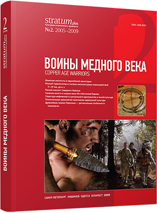Некрополь Cоюг Булаг (материалы к изучению кавказско-переднеазиатских связей)
Soyug Bulag Necropolis
Author(s): Tufan AkhundovSubject(s): History, Archaeology, Ancient World
Published by: Издательский дом Stratum, Университет «Высшая антропологическая школа»
Keywords: Republic of Azerbaijan; village Kechveli; South Caucasus; migrations;
Summary/Abstract: The site is situated in the north-west of the Republic of Azerbaijan, 1.5 km to the east from the village Kechveli of the Agstafa region. The burials are divided in two groups: funeral chambers arranged in holes (1/2005, 1/2006, 3c/2006, 3d/2006, 4/2006) and burials on funeral grounds arranged on the surface (2/2006, 3a/2006, 3b/2006, 5/2006, 6/2006). Chambers of the wall in the holes are covered by adobe. In one case the wall was finished by clay. There are also chambers of small size without brick facing (3s/2006, 3b/2006). The chambers had wooden floorings and were covered by earth and stone. Low caps on the horizon were begirt by the cromlech. The social property exfoliation is observed here.Funeral grounds on the surface were contoured by stone ruins. Probably they have been fenced and covered by surface constructions of cane and clay, which have been strengthened by stone in the base. The grounds were surrounded by the tape cromlechs.Both in case of the tumulus with funeral chamber (1/2006) and the tumulus with funeral ground (6/2006), there were sacrificial pits to the north-west of them.The collection of objects consists of a small amount of ceramic, metallic and stone samples. Their overwhelming majority was found in the tumulus 1/2006. These are a zoomorphic scepter, a copper dagger, gold, silver, cornelian, ceramic and other beads. On the tumulus 4/2006, a copper-nickel pin and a ceramic collection were found. All these give the grounds to speak about the belonging of the mentioned sites to the post-Leylatepe or to the Maykop stage of development of the Ubeyd-Uruk-Leylatepe-Maykop tradition which in reality are the stages of the same indivisible cultural-historical process.The bearers of the Maykop tradition seem to have left Soyug-Bulag necropolis in the second half – late IV millennium B.C. moving from the North Caucasus to the South, probably during separate seasons of the year. This process seem to have partially continued in the late IV – early III millennium B.C. The migration to the south was not limited to the South Caucasus. These migrations were much wider and this is a subject for a separate study. Nowadays it is possible to speak about the bearers of the Maykop culture in the north-western Iran (South Azerbaijan-Si Gerdan), about their relations, via the South Caucasus, with Central (Badakhshan-Sarazm) and Minor Asia (Malatya-Arslantepe).
Journal: Stratum plus. Археология и культурная антропология
- Issue Year: 2009
- Issue No: 2
- Page Range: 523-544
- Page Count: 22
- Language: Russian
- Content File-PDF

